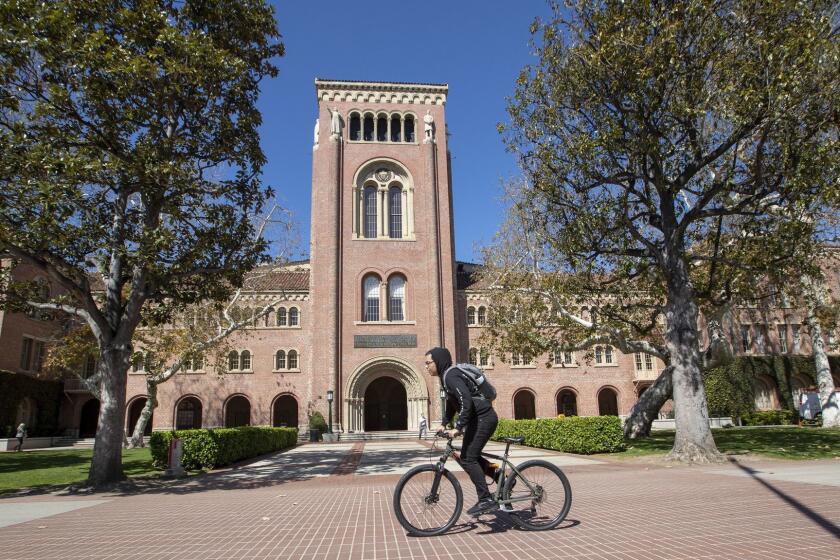College health insurance costs vary widely. But there are plenty of options

Are you among the 400,000 freshmen in California — or 2.9 million nationwide — who have just started college or are about to? As you buy your books, ponder the best meal plan or wonder whether you will get along with your roommate, don’t forget about health insurance.
Whether you’re an undergrad or graduate student, your options will depend on where you go to college, if you already have coverage through a family or individual health plan, and how much money you make.
It might surprise you to know you could qualify for no-cost Medicaid, the public health insurance program for people with low incomes.
“The good news is there are a few good options,” says Paul Rooney, vice president of carrier relations at EHealth, an online health insurance broker based in Santa Clara, Calif.
California college students say the biggest obstacle to success are costs and juggling work with school, surveys says.
Since health plans vary from region to region and state to state, your first call might be to an insurance agent in the market where your college is located to discuss your options. The help is free. In California, you can find certified insurance agents on the “Find Help” tab of the website of California’s Obamacare marketplace, Covered California.
Sometimes, staying on your family’s plan is the best option — and you can do so up to age 26.
If you are on your family’s plan or you have your own insurance, call the customer service number on your insurance card to ask about the level of coverage, if any, it will provide if you attend college in another region or state.
If your family health plan is a preferred provider organization with a national insurance company — Cigna, Aetna or UnitedHealthcare, for example — you often can get full medical services at in-network prices in other regions of the country where your insurer operates.
But it also has to work financially. Parents, ask your employer or your insurer if taking your child off the family PPO will lower your premium. If the answer is no, and your child will have full network coverage while away at college, it makes sense to keep your kid on the plan.
If the answer is yes, do the math.
Keith Wakeman, chief executive of a Chicago-based mental health app start-up called SuperBetter, learned he would save $1,900 this year by taking his son Jack off the family’s Blue Cross PPO and buying him the student plan offered by Purdue University, where he is a freshman.
“The plan is much better for Jack in terms of deductibles and copays — and also includes vision and dental,” Wakeman says. “It was a no-brainer for us.”
When I arrived at USC 11 years ago as dean of religious life, my pastoral conversations with students mostly focused on their quests for meaning and purpose.
It probably also makes sense to take your student off the family plan if it is a health maintenance organization or an exclusive provider organization, both of which restrict their networks more than PPOs.
There are exceptions: Some insurers allow HMO enrollees to get full medical services at no extra cost in other regions or states where they operate. Ask your health plan if that’s possible.
If it’s not, the health plan offered by your college could be a good option.
Student health plans have improved in recent years, in part because they almost always comply with the Affordable Care Act’s coverage requirements. That means most offer a comprehensive range of medical services at a high level of coverage, says Stephen Beckley, a senior partner with Fort Collins, Colo.-based Hodgkins Beckley Consulting, which works with colleges on student health programs.
The UC system’s health plan is “exceptional,” Beckley says, “because of its highly favorable cost and the addition of vision and dental benefits.”
Nationally, costs vary widely from college to college, and some are very high, Beckley says.
The cost of this year’s UC undergraduate student health insurance plan, which includes all campuses except Berkeley, ranges from $1,773 to $3,537 for 12 months of coverage, according to Zina Slaughter, the plan’s director. Stanford University, by contrast, charges $5,592 for undergraduate and graduate students.
Beware: Many universities, the UC system and Stanford included, will enroll you in their health plan automatically, and you must obtain a waiver — by proving you have other acceptable coverage — to avoid the charges.
“We tell people that you should make sure you’re not being opted into services you won’t use,” says Erin Hemlin, director of health and policy advocacy for Young Invincibles, a nonprofit that promotes the interests of young adults.
If your family plan doesn’t work for you anymore and your college plan is too expensive, check to see if you qualify for no-cost Medicaid, which goes by the name Medi-Cal in California and insures one-third of the state’s residents.
This goes for students at private universities and public schools, including the 481,000 students at the 23 Cal State campuses and the more than 2 million who attend one of the state’s 115 community colleges.
In the more than 30 states that have expanded Medicaid, including California, individuals who make up to about $17,200 annually are eligible for the program. It helps if your parents do not claim you as a dependent on their tax returns; otherwise, you must report their income.
Sylvia Colt-Lacayo is largely on her own to figure out how to pay for the care she needs to live on campus with a degenerative neuromuscular disability.
Check with the health department in your county to see if you qualify. The Department of Health Care Services has a list of California county offices.
If your income is too high for Medicaid, you might still qualify for a subsidy to buy a health plan through your state’s Obamacare insurance exchange. In California, log onto the Covered California website or call (800) 300-1506 to research options.
Enrollment in 2020 Obamacare exchange plans starts Oct. 15 for Covered California and Nov. 1 in most of the rest of the country.
Experts say a viable option for some students who are on their family’s plan is to stay on it, getting emergency care at a local hospital if necessary and basic primary care at the on-campus clinic (access is often included in student fees). They can wait to get physical checkups and other non-urgent care until they visit home.
Giorgia Winters, a resident of Long Beach, said that was the decision she and her husband made for their son Matthew, 18, who just entered Embry-Riddle Aeronautical University in Prescott, Ariz. They don’t worry about his health: He had to pass a Federal Aviation Administration fitness test to pursue his pilot’s license at the school.
“He’ll come fairly often, because Prescott is an hour or so away by airplane,” Winters says. “I don’t know how much better it is financially, but it was more comfortable for us.”
Bernard J. Wolfson writes for Kaiser Health News, an editorially independent publication of the Kaiser Family Foundation.








